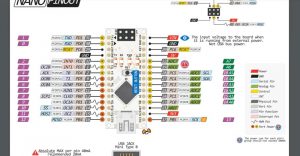

Used to receive (RX) and transmit (TX) TTL serial data. In addition, some pins have specialized functions: Each pin can provide or receive a maximum of 40 mA and has an internal pull-up resistor (disconnected by default) of 20-50 kOhms. They operate at 3.3 or 5 volts (depending on the model).
#Arduino nano pinout pwm pro
Input and OutputĮach of the 14 digital pins on the Pro Mini can be used as an input or output, using pinMode, digitalWrite, and digitalRead functions. It has 2 kB of SRAM and 1kBs of EEPROM (which can be read and written with the EEPROM library.

The ATmega328P has 32 kB of flash memory for storing code (of which 0.5kB is used for the bootloader). RAW For supplying a raw voltage to the board. If you're supplying unregulated power to the board, be sure to connect to the "RAW" pin on not VCC. There is a voltage regulator on board so it can accept voltage up to 12VDC. The Arduino Pro Mini can be powered with an FTDI cable or breakout board connected to its six pin header, or with a regulated 3.3V or 5V supply (depending on the model) on the Vcc pin. On the Product itself through our Customer SupportĪrduino Pro Mini is open-source hardware! You can build your own board using the following files:.You can find in the Getting Started section all the information you need to configure your board, use the Arduino Software (IDE), and start tinker with coding and electronics. You can find here your board warranty information. The Arduino Pro Mini was designed and is manufactured by SparkFun Electronics.

One runs at 3.3V and 8 MHz, the other at 5V and 16 MHz. The pin layout is compatible with the Arduino Mini. The board comes without pre-mounted headers, allowing the use of various types of connectors or direct soldering of wires. The Arduino Pro Mini is intended for semi-permanent installation in objects or exhibitions. A six pin header can be connected to an FTDI cable or Sparkfun breakout board to provide USB power and communication to the board. It has 14 digital input/output pins (of which 6 can be used as PWM outputs), 6 analog inputs, an on-board resonator, a reset button, and holes for mounting pin headers. The Arduino Pro Mini is a microcontroller board based on the ATmega328P. Note: This page refers to a product that is retired.


 0 kommentar(er)
0 kommentar(er)
